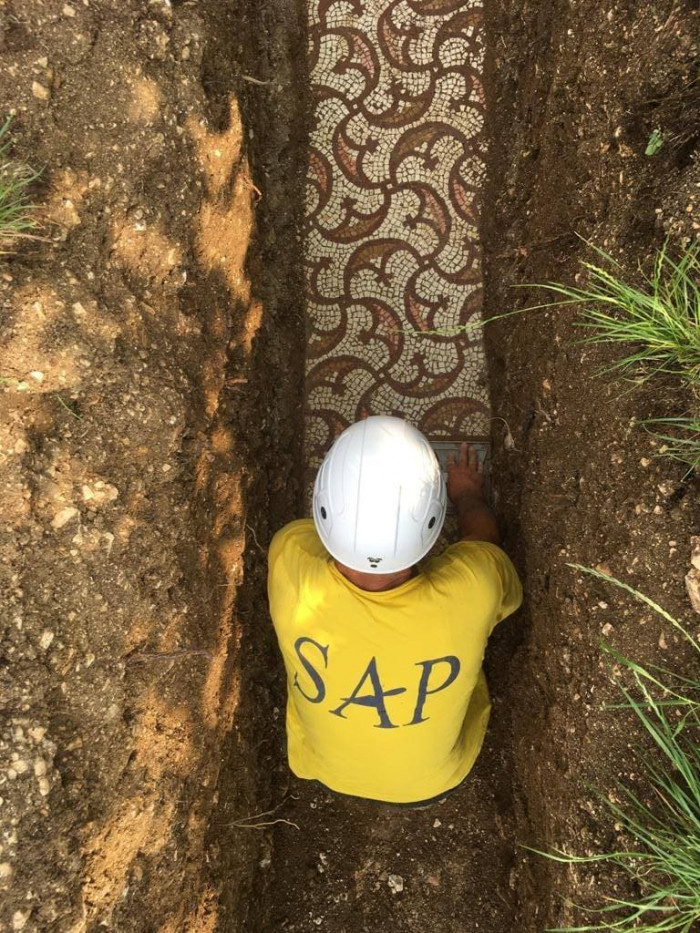
2000-Year-Old Roman Artifact Discovered By Archeologists In Northern Italy, But What Stunned Scientists Is How It Has Remained In Perfect Condition Throughout The Centuries
Beautiful patterns and vibrant colors adorn this ancient Roman mosaic floor, which has remained virtually untouched for millennia.

Everywhere you turn to in Italy, there are hidden treasures and monuments that date back to the most ancient of times, which given the country's illustrious past, comes as no surprise. Italy offers it all: wine, tourism, and museums filled with art and culture.
You might even suggest that Italy is like Disney World for history buffs and those interested in ancient cultures and treasures. That would be something difficult to argue with, honestly.
When one thinks of Italy, what they usually envision is the Coliseum, the Leaning Tower of Pisa, and Michelangelo's David. However, there's so much more to be discovered in Italy that many people are unaware of its existence.
An exciting find was recently made by Archeologists while excavating a private vineyard, just one example of the city's rich cultural and historical legacy. The stunning discovery was an ancient mosaic floor that was unearthed in the northern Italian town of Verona, and to everyone's amazement, the floor was still in pristine condition.
The floor is priceless antiquity from ancient Rome, dating back to the first century CE. In accordance with local lore, the site where the mosaic floor was discovered was formerly atop Roman relics originating from the 1900s.
Here's a glimpse of the rare discovery:
A team from the Superintendent Of Archaeology, Fine Arts And Landscape Of Verona, examining the mosaic floor.
 SAP Società Archeologica / Facebook
SAP Società Archeologica / Facebook SAP Società Archeologica / Facebook
SAP Società Archeologica / Facebook
Local authorities from Comune di Negrar di Valpolicella released a statement to acknowledge this remarkable discovery.
After countless decades of failed attempts, part of the flooring and foundations of the Roman Villa located north of the capital, discovered by scholars over a century ago, has finally been discovered.
They continued, pledging support to assist the scientists in making the archeological treasure "available and visitable."
The technicians of the Superintendence of Verona, with a targeted soil carrotage, are partially discovering the remains of the artifact still present under a few meters of earth, with a precise goal: to identify the exact extension and exact location of the ancient construction. Subsequently, the Superintendence will connect with the owners of the area and the Municipality to identify the most suitable ways to make this archaeological treasure hidden under our feet available and visitable.
The result won’t come soon and significant resources will be needed. But it’s important, finally, to track the road. The Municipality will lend all the necessary cooperation and thanks from now on to the Superintendence professionals and the owners of the area for the unity of intent and the availability with which they are pursuing the project.
The mosaic floor, to the surprise of everyone, has been perfectly preserved over the centuries.
 SAP Società Archeologica / Facebook
SAP Società Archeologica / Facebook
Some noticeable features of this ancient roman artifact include stone tesserae, with vibrant colors and intricate details. For anyone who is knowledgeable about Roman history, seeing the floor is like taking a step back into time.
Italian history makes finding Roman mosaics rather prevalent. Because of its strategic placement near important thoroughfares, Verona, in particular, was a vital colony in ancient Rome.
This discovery is a big win for the local community in Verona.
 SAP Società Archeologica / Facebook
SAP Società Archeologica / Facebook
Floor mosaics were often used in ancient Rome as decoration and were found inside houses that belonged to upper-class families, who used them as a traditional Roman art style. They usually depicted mythological and historical events.
Ancient Roman artists utilized this style of artwork to tell stories, mostly about gods and heroes. Animals and landscapes were also common themes for the Roman floor mosaics.
It's amazing to think that this artifact has survived for over 2000 years, and now the public can finally enjoy the beauty of ancient Rome.
There are so many things to do in Italy, and if history is your forte, then there's no better place than Verona! Here you can find stunning churches that date back to medieval times, which were built on top of even older Roman ruins, making this city one big treasure trove waiting to be discovered.
Have you ever witnessed the beauty of historical sites? If so, we'd love to hear about your experience in the comments below!
Jesse







